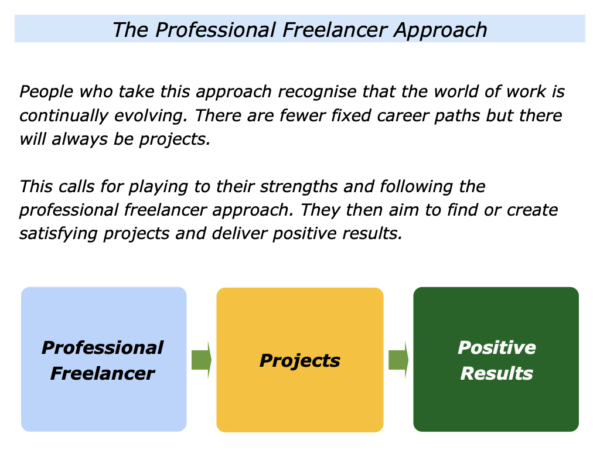
Great workers recognise that the world of work continues to evolve. There are few predictable career paths anymore but there will always be projects.
This calls for playing to their strengths and having a professional freelancer approach. They then aim to find or create satisfying projects and deliver positive results.
Such people take this approach even if they are a full-time employee. They maintain the freelance mentality and operate as if they are on a rolling contract. They aim to behave in a professional way and help their stakeholders to succeed.
Different people follow this path in different ways. Let’s explore how some people pursue these themes.
Professional Freelancer
People who take this approach build on their strengths and have a strong service ethic. They also aim to find or create satisfying projects where they can deliver success.
Such people are proactive and agile. They keep scanning their chosen field to focus on: a) the specific challenges that their potential customers are facing; b) the specific challenges they may face in the future.
Different people then clarify their offering to potential customers in different ways. One approach is for them to explore the following themes.
Strengths
What are my strengths? What are the specific activities where I can deliver As rather than Bs or Cs? What are the kinds of work I find most satisfying to do? What are the specific things I can deliver to help people to tackle challenges or achieve their goals?
Specific Customers
Who are my perfect customers? Who are the kinds of people, customers or organisations with whom I work best? What may be some of the challenges these people face? What may be the specific goals they want to achieve?
Success
How can I use my strengths to help some of these people achieve success? What are the specific things I can deliver to help them to improve their profits, products or people? What would be the benefits of delivering these things – for them, their organisation or their customers?
Imagine that you want to follow this approach and have explored the themes mentioned above. If appropriate, you can then aim to define your professional offering. Here is the exercise on this theme.
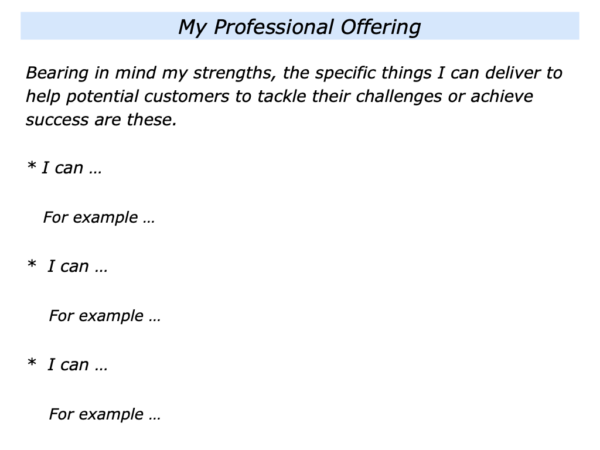
Professional freelancers clarify where they can use their strengths to help others to achieve success. This involves exploring the following theme.
Projects
Imagine that a person is actually working as a freelancer. They have clarified their strengths and the kinds of people with whom they work best.
The next step is to identify what for them would be a stimulating project. It may not always be possible to find such projects, but this can help to clarify where they may be able to do superb work.
Imagine that you want to follow some of these steps in your own way. Let’s start with focusing on your ideal project.
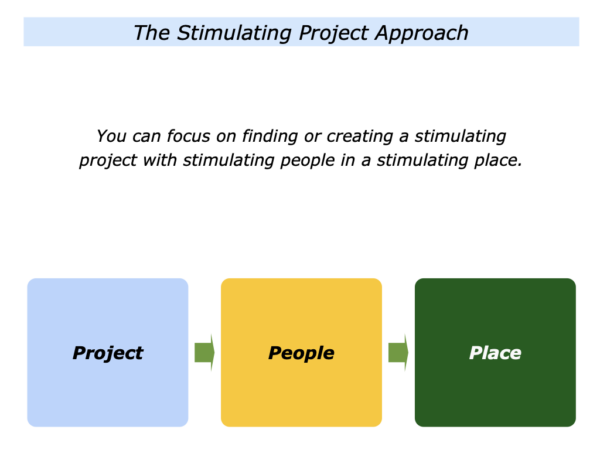
As mentioned earlier, we are all self-employed now. There are no jobs anymore, there are only projects. So how can you find or create a satisfying project and, if appropriate, get paid a salary?
One approach is to start by clarifying the characteristics of the project, people and place you find stimulating. Let’s consider how to take these steps.
Project
What are the characteristics of the projects you find stimulating? One person answered this question in the following way.
“Looking back at the satisfying projects I have done in the past, I can identify some patterns. They have to do with helping people or improving the quality of their lives.
“At university I organised the first ever sponsored Fun Run, raising £10k for charity. Early in my IT career I launched software that enabled students to take charge of their own learning.
“In some ways I consider myself a bit lazy, so I prefer projects that have a deadline. This forces me to get my act together. I then rise to the occasion and deliver the goods.”
Other people mention other qualities when answering this question. Here are some of the answers.
The kinds of projects that I find
stimulating are those that involve:
Doing work I believe in … Having lots of autonomy … Helping other people … Passing on knowledge … Caring for animals … Creating beautiful things … Doing deep work … Turning around companies.
Launching prototypes … Selling to certain kinds of customers … Helping people to heal … Working with people from different cultures … Learning new things … Leading superb teams.
If you wish, try tackling the exercise on this theme. Describe the characteristics of the kinds of projects that you find stimulating.
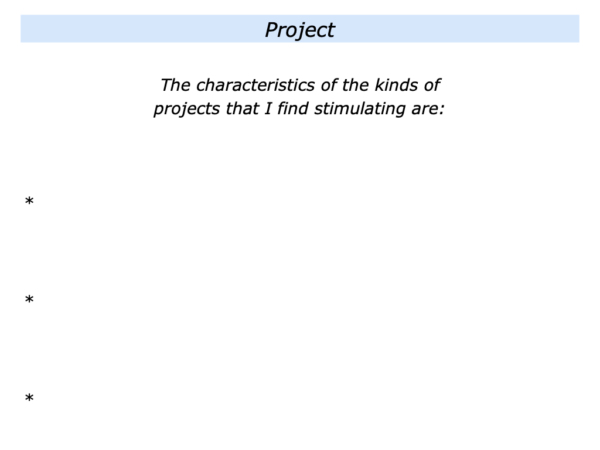
People
What are the characteristics of the customers and colleagues that you find stimulating? Let’s explore these themes.
Customers
Whilst you will always aim to be professional, there may be certain kinds of customers with whom you work best. Here some answers that people give when exploring this theme.
“I work best with people who aim to be pioneers, pacesetters or peak performers. Such people often aim to make the new rules for the game. I am not so good at working with customers who work in established institutions.”
“I work best with people who are committed to giving great service to their customers. Many of my customers work in retail, hospitality or the entertainment industries. They want to be commercial but also provide great experiences for their customers.”
“I work best with leaders who recognise that, whilst they can set the tone, they will be judged by the performance of their people. Such leaders combine being decisive with being open to exploring many ideas. They then implement these in their own ways to build successful organisations.”
Colleagues
The people you work with every day are crucial. One leader described how it was important for them to have the autonomy to hire people who deliver the required professional standards. They explained this in the following way.
“I am happy to be accountable for the results, but I also try to make sure I have the required autonomy and authority. This is because of some bad experiences in the past.
“Many years ago I took on the role of turning around a dysfunctional team. This had several unmotivated team members who had seen off several managers.
“I made the mistake of assuming that, if I could find the keys to motivating them, everything would be okay. But this didn’t work.
“My manager procrastinated when I asked for the authority to replace some of the team members. Eventually it got so bad that I left.
“Whilst it is my job to create a positive environment, I work best with people who behave like professionals. I can then do my best to guide the team to success.”
If you are a contract worker or team member, however, it can be more challenging when working with difficult colleagues. You can aim to behave in a positive and professional way, but you will have limited power to pick your colleagues.
Bearing this in mind, it can be useful to do your due diligence before taking a role. You can do research about the people with whom you will be working. If you decide to go ahead, you can focus on:
How you can build with the people with whom you may work best;
How you can manage any other relationships in a professional way.
Managers
Everybody has key stakeholders whom they need to keep happy. These may include the leaders, the board or the investors. One of the key relationships will be with your manager.
Good managers create a positive environment in which self-motivated people can do superb work and deliver success. Poor managers can make people’s lives miserable.
Looking back, can you think of the managers with whom your worked best? What were the characteristics of these managers? Bearing these in mind, what are the qualities you want in your ideal manager?
One person answered this question in the following way. They echoed many of the common themes that people mention when describing their ideal manager.
“I work best with a manager who is professional and whom I respect. It is helpful if we agree on the What – the outcomes to achieve – and when these must be delivered.
“We make clear contracts about: a) the specific things I will deliver by when; b) the specific things I will do to keep them informed about the progress; c) the specific kinds of support that will help to deliver the outcomes.
“I then like to have the freedom – within agreed parameters – regarding how I use my strengths to do the work. The key, of course, is that I must deliver the agreed goals.”
Most people do not like to be micromanaged, but they also recognise it is important to manage upwards. They need to get some early wins, proactively keep their manager informed and deliver the agreed picture of success.
If you wish, try tackling the exercise on this theme. Describe the characteristics of the kinds of people that you find stimulating to work with.
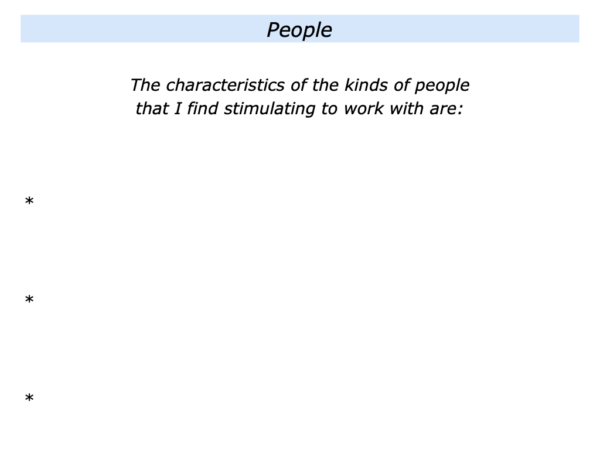
Place
What are the characteristics of the place – the culture and environment – you find stimulating? Here are some of the answers that people give to this question.
“I like working in pioneering businesses. They are also results focused and fast paced, which suits my style. It also feels like we are creating the rules for the future.”
“I like working in organisations that are established yet innovative. Early in my career I worked in start-up businesses, but now I like places that are professional, informal but also have more infrastructure. At the same time, I want freedom to be creative.”
If you wish, try tackling the exercise on this theme. This invites you to describe the characteristics of the kind of workplace that you find stimulating.
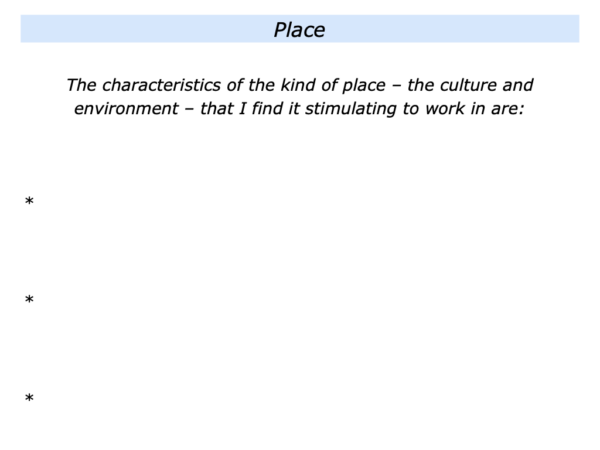
Let’s return to your professional offering. You know your strengths. You also know the specific things you can deliver to help people to achieve their goals. You also know the kind of project you find stimulating.
The next step is to potential customers. Let’s explore how it may be possible to take this step.
Potential Customers
Imagine that you have an empty diary and want to find work. How to make this happen? One approach is to take the following steps.
To get work by going out and helping people to succeed;
To translate some of this work into doing specific projects;
To build on this work and find or create a stimulating project and then deliver success.
Let’s consider some of the approaches you can follow to take these steps and get paid work.
Getting Work By Going Out
And Helping People To Succeed
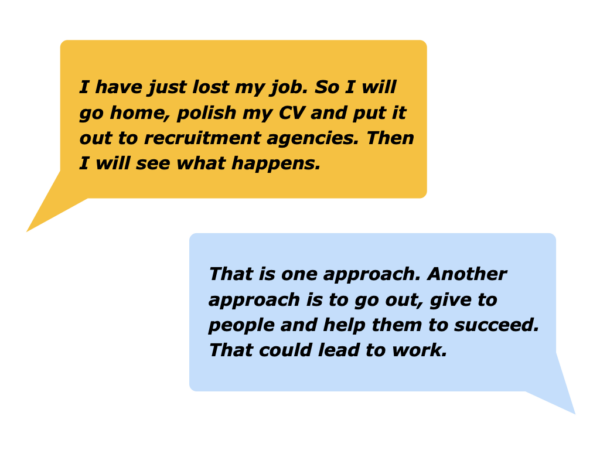
The old proverb says: “Some people make things happen, some watch while things happen and some wonder ‘What happened?’”
Certainly this was true during a recent recession. Some people who lost their jobs tried to figure out what had happened and looked for somebody to blame.
Others adopted different strategies when pursuing their job search. Here are examples of the different approaches taken by two people.
Person A said:
“I am going to spend time polishing my CV and registering with recruitment agencies. Then I am going to reconnect with people I know. That is something I should have done before, but I am not good at promoting myself.”
Person B said:
“There are lots of jobs out there where I can help people. You can’t tell me that every project and every piece of work in the country is on time, on budget and on course to reach its goals.
“Somewhere there are bound to be unsatisfied customer needs. So I am going to get out there and help other people to succeed.”
Imagine that you face the prospect of an empty calendar and want to find satisfying work. Building on the ideas mentioned, you may want to take the following steps.
You can aim: a) to clarify your strengths; b) to clarify the specific kinds of people with whom you work best; c) to clarify the specific things you can deliver to help those people to achieve success.
This is a good start but then comes the real task. How to get work? Some of the following ideas may seem counterintuitive but I have seen them work. One approach is to simply give to people.
Sometimes this involves passing on knowledge via email or a blog. Sometimes it involves meeting a person and sharing ideas they can use to achieve their goals. Sometimes it can involve doing work for free.
Different people follow this approach in different ways. Here is one example from a person that found work.
“The recession taught me a lot. My first reaction was to worry about maintaining an income. My second reaction was more interesting. I reframed the situation as an opportunity to help people.
“Over the years I have built a business as a mentor but that suddenly became a luxury purchase. Despite funds being cut, I offered my time to meet clients five days a week.
“Mentoring is often about helping people to make good decisions. So my clients and I explored the tough choices they needed to make regarding shaping their future businesses.
“On the practical side, the first aim was to cover my weekly costs, which proved possible.
“After a month or so several clients asked me to do various project work. This included helping teams to complete internal projects, improve customer service and develop new business.
“These projects were funded from the technology and marketing budgets. Previously my work had been paid for by Human Resources.
“Nowadays my diary is full. But I am concerned about the next dip in the market. So it is time to go out and give to people again.”
Imagine you want to get work. You will probably start by following one of the first rules:
You can make getting
a job a full time job
Successful job seekers follow this path. They cram their days with activities most likely to get them in front of people. They also follow the next rule.
Your next job will most likely come
from the people in your network
It will come from either: a) people you know or; b) people you know who recommend you to other people. Some people say they are no good at networking because they think it involves self-promotion. It doesn’t.
Real networking is about
helping other people to succeed
Sounds crazy? Perhaps. But giving to people – such as encouraging them or passing on knowledge – can be extremely rewarding. It can sometimes also lead to future work possibilities.
People buy people. Whilst CVs may look good, most buyers in the market want somebody whom they can trust, somebody who they know can deliver. One person expressed this in the following way.
“Every job I have had over the past 20 years has come from my network. Twice during that time the companies I was employed by got taken over and my job disappeared. So it was then time to reconnect with people who knew what I could deliver.
“The hard part was getting started. I spent masses of time visiting people. Being customer focused, I made sure the conversation was about them and their company challenges. It was not about me.
“I followed up every visit with an email framing possible ideas they could use to tackle specific challenges. Several times this led to contract work with somebody saying: ‘How can we take this further?’
“This is how I have got my last two jobs. I started by doing pieces of project work and then moved into full-time employment.”
This approach raises an important point: How to reach or keep in touch with your potential customers? This highlights another rule:
Keep in touch with people in a way that
fits your values system and natural style
Do things that put a spring in your step. You can share knowledge, recommend books, offer to provide a pair of hands or connect like-minded people by putting them in touch with each other.
You can also create a website that acts as a shop window and make it customer focused. You can produce articles, pass on knowledge and offer practical tools that people can use to achieve success.
Like an actor, it’s vital to keep working. Do something every day to reach people in your network but be patient. It can take time before the right opportunity appears.
Try tackling the exercise on this theme. Draw a map of your network. Write the names of people, customers, colleagues, friends and others in your network.
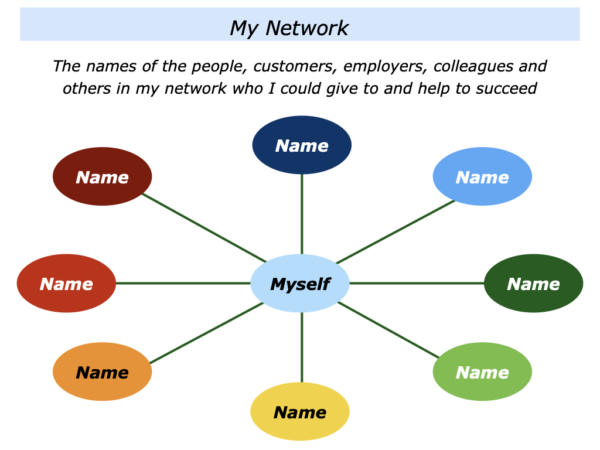
Looking at your network, describe the challenges that each person faces. Describe the specific things you can do to give to each person and help them to succeed.
Here is the exercise on this theme. This provides space for focusing on just one person. But it can be important to use your imagination and do it for as many people as possible.
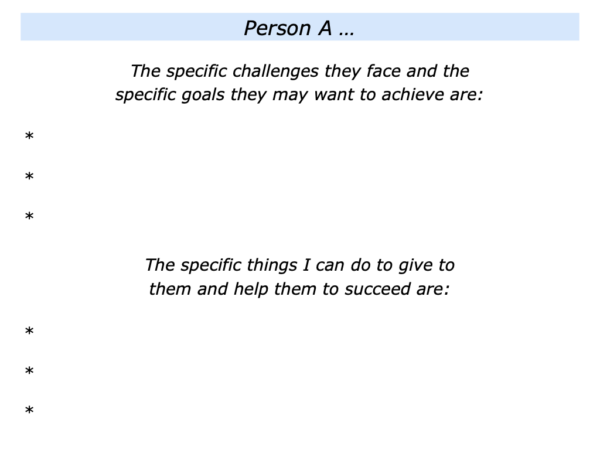
The best time for a person to network is when they are successful rather than when they want something. They then have greater strength to give to others. Paradoxically, they may find that even more opportunities come their way.
Finding A Need And Filling It
There are many ways to do satisfying work that earns a salary. One approach is to follow the old advice of ‘Find a need and fill it.’ This involves exploring the following questions about the present and future needs of potential customers.
Are there any organisational strategies that need to be implemented more successfully? Are there any potential future organisational strategies that need to be piloted successfully?
Are there any present customer needs that need to be met more successfully? Are there any potential future customer needs that need to be anticipated and met successfully?
Are there any potential people issues that need to be tackled successfully? Are there any professional skills or other qualities that people need to develop to deliver success? Are there any other things that can be done to help people to achieve peak performance?
Are there any processes that need to be improved to help the organisation achieve success? Are there any prototypes that need to be built to help the organisation achieve future success? Are there any other challenges to address to help the organisation achieve ongoing success?
Looking at these needs, are there any where I could use my strengths to help the organisation to achieve present or future success? If so, how can I position this in a way that makes it attractive to the organisation.
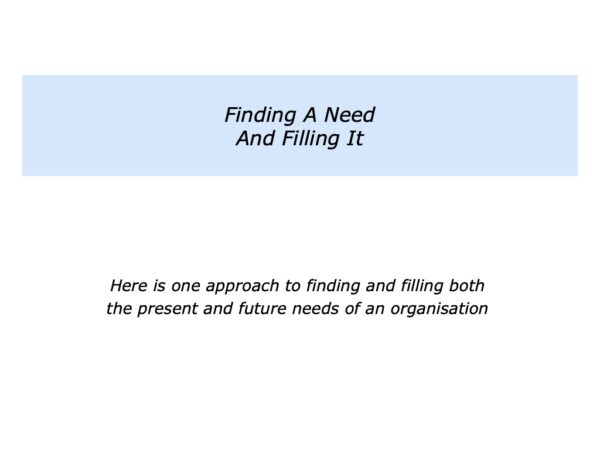
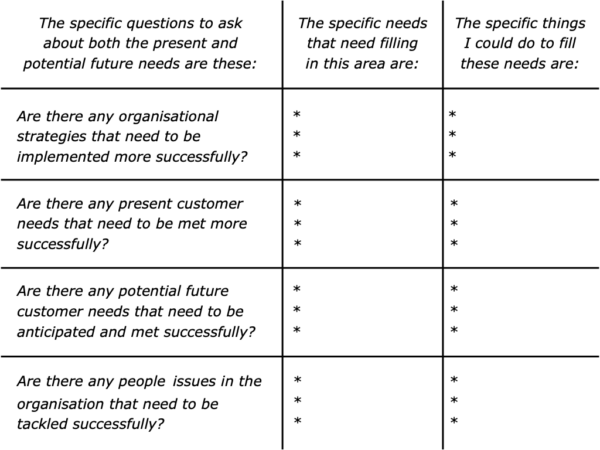
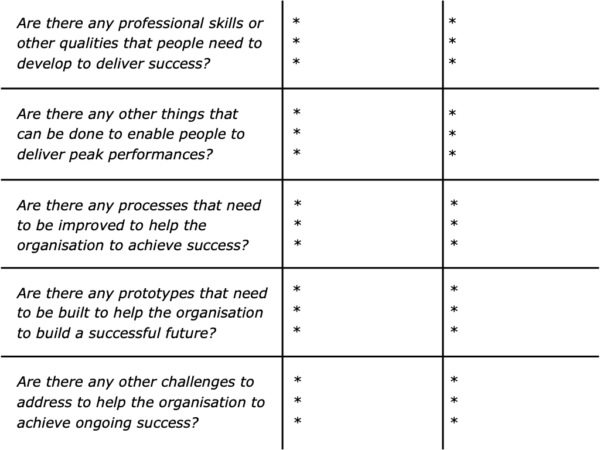
Professional freelancers follow their preferred approach to keeping in touch with people in their network. When appropriate, they find a way to have a conversation with potential customers. They then aim to act as a trusted advisor rather than doing a hard sell.
Before having such a conversation, they research what may be happening in that person’s world. They aim to clarify:
The challenges the person may face in their team, organisation or market;
The knowledge, positive models and practical tools they could pass on to help the person succeed.
During the conversation they aim to help the person to feel at ease and able to explore. At an appropriate point, they may ask about the kinds of challenges that the person may face.
Following the trusted advisor approach, they then ask if it is okay to share some ideas. If so, they try to pass on knowledge that resonates with the person and can help them to achieve their goals.
Much then depends on the potential customer’s reactions. These may include the following kinds of responses.
They may simply listen and process the ideas in their own way;
They may thank them for the ideas and say they may get back to them;
They may show an interest in the ideas and say something along the lines of: “How can we take this further?”
Imagine that the conversation leads to the potential customer hiring the freelancer to do a piece of work. This can lead to the next step.
The Specific Project – Making Clear
Contracts About The Picture Of Success
Clear contracting is crucial in many areas of life. This is especially so when providing professional services. There are many ways to make such contracts.
Looking at my own work, the pattern has been to agree on this verbally and then summarise it in a follow-up email. Some people prefer to formalise the agreement in a more formal manner.
Professional freelancers find it be useful to make clear contracts in the following areas.
The specific results to achieve;
The specific strategies to follow to increase the chances of achieving the results;
The specific responsibilities of each party in working to achieve the results;
The specific support that may be needs to achieve the results;
The specific measures that will show they have achieved the results.
This is an approach that can be followed by actual freelancers or by full-time employers in organisations. Here is a framework that can be followed to make such a clear contracts. Taking this approach can increase the chances of achieving success.
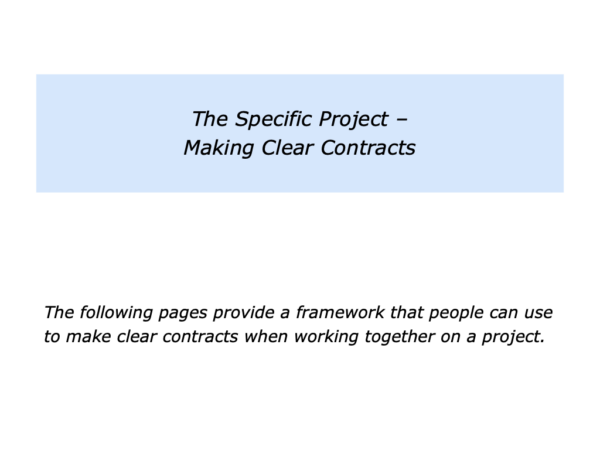
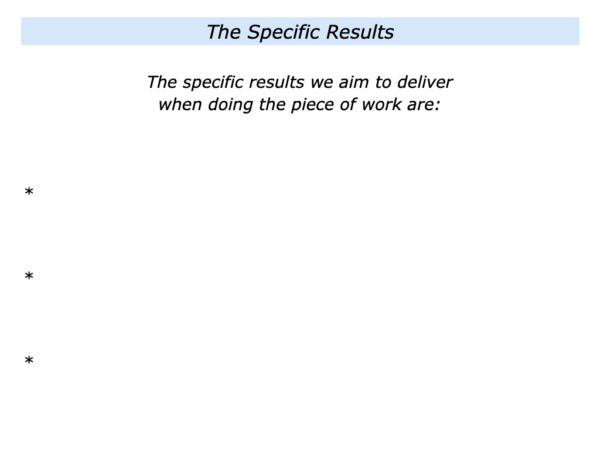
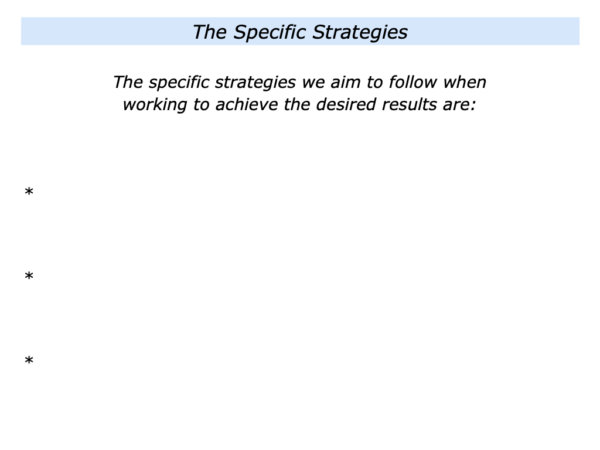
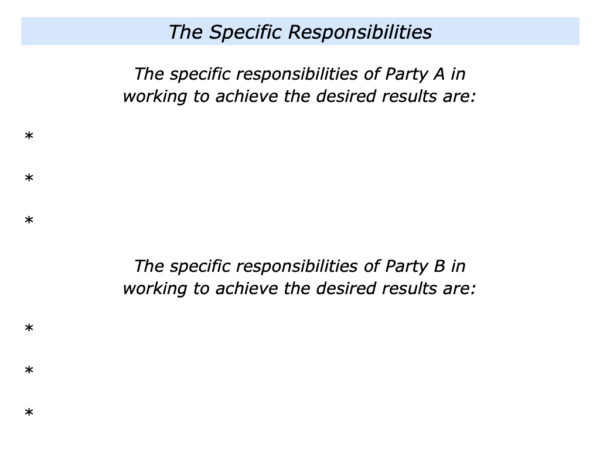
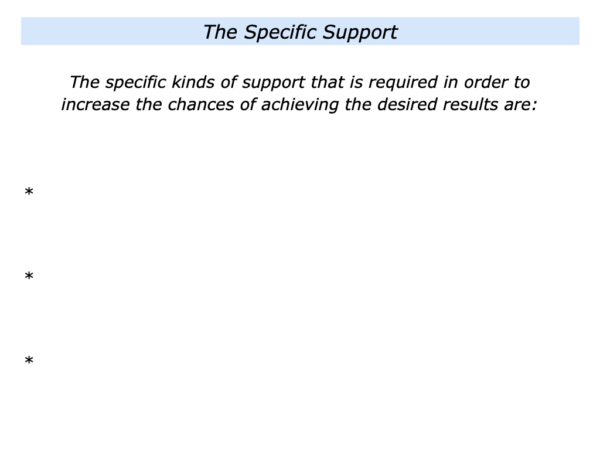
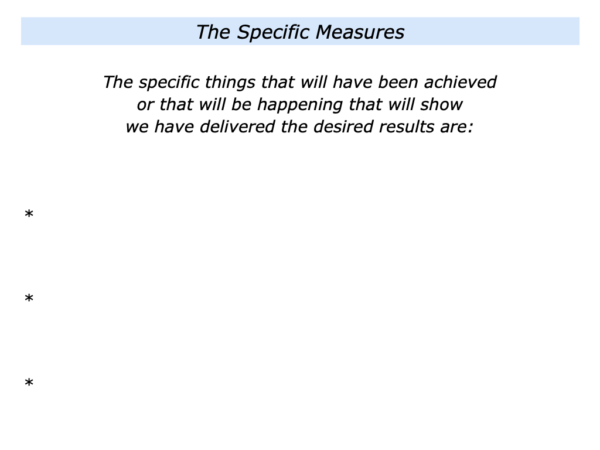
Imagine that the professional freelancer has made clear contracts with the key stakeholders. They then focus on the next theme.
Positive Results
Great workers do their best to deliver the goods. They believe it is vital to do superb work, give great service and deliver success. They behave in this way whether they are freelancers or full-time employees.
Such workers recognise they are always on stage, they therefore behave in a positive and professional way towards all people. They also apply their specialist knowledge to help people to succeed.
Some imagine that they are on a rolling contract that is to be reviewed every three months. (They do this even if they are full-time employees.) They continue to focus on the following themes.
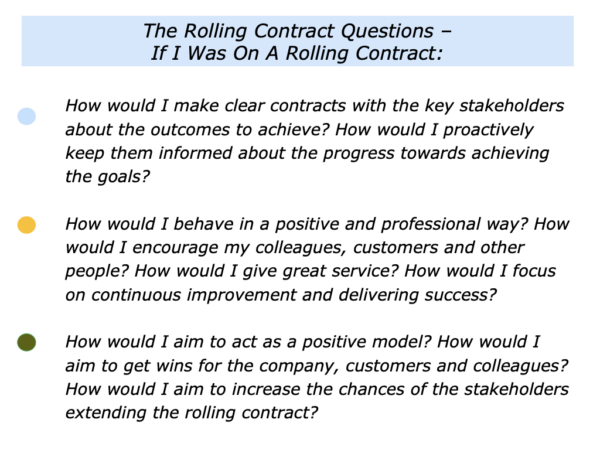
Professional freelancers are good finishers. They find solutions to challenges and deliver the goods. Sometimes they do this by adding that touch of class.
Such people recognise, however, that their contribution may be evaluated by different stakeholders in different ways. These may include the following criteria.
The Professional Freelancer’s Contribution
The key stakeholders may ask the following questions
about the professional freelancer’s contribution
Did they deliver the agreed specific results? Did they behave in a positive and professional way? Did they use their skills to encourage other people and help them to succeed?
Did they, in their own way, pursue the principles we like to follow in our organisation? Did they focus on helping us to achieve our goals rather than any personal agenda?
Would we hire them again if a possibility arose? If so, what would we like them to keep doing? What might we want them to do differently? Would we see them as an asset to our organisation?
Professional freelancers continue to maintain high standards. If and when appropriate, this can even lead to them being offered a full-time role. They may take this role but they also retain their entrepreneurial mentality.
Such workers are aware that things can change quickly. Companies can be taken over, crises can happen and unexpected events can shake the market.
They continue to give 100%. But they recognise that their present project – even if it is a full-time role – may end at some point. They therefore often develop a back-up plan.
Professional freelancers – and those who have a similar mentality – focus on shaping a positive future. They therefore continue to explore the following questions.
What are my strengths? How can I use my strengths to help people, teams or organisations to succeed? How can I find or create the next satisfying project?
Imagine that you want to follow elements of the professional freelancer approach. How can you do this in your own way? How can you translate these ideas into action? What may happen as a result of taking these steps?
If you wish, try tackling the exercise on this theme. This invites you to complete the following sentences.
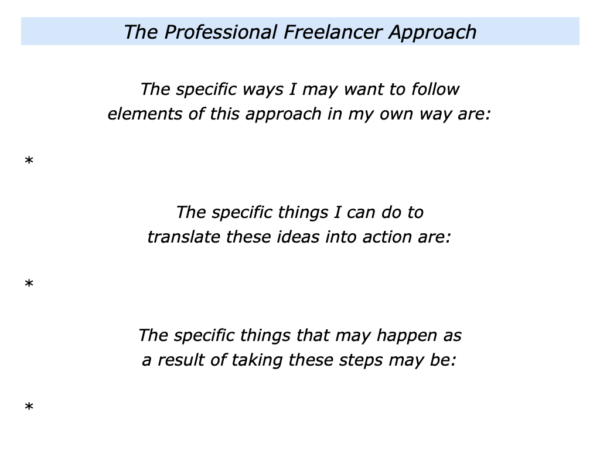


Leave a Reply